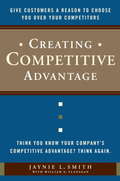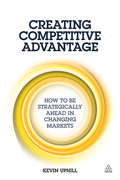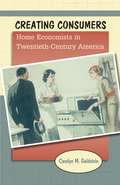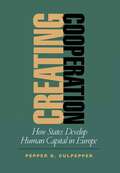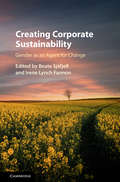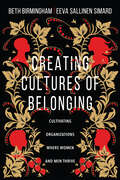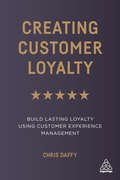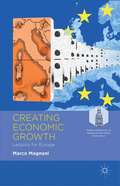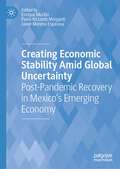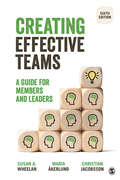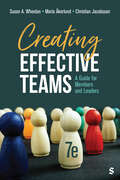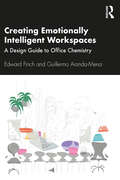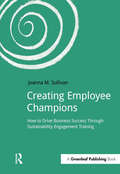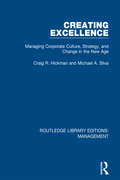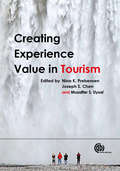- Table View
- List View
Creating Competitive Advantage
by Pankaj Ghemawat Jan W. RivkinA firm such as Schering-Plough that earns superior, long-run financial returns within its industry is said to enjoy a competitive advantage over its rivals. This note examines the logic of how firms create competitive advantage. It emphasizes two themes: First, to create an advantage, a firm must configure itself to do something unique and valuable. The firm must ensure that, were it to disappear, someone in its network of suppliers, customers, and complementors would miss it and no one could replace it perfectly. The first section uses the concept of "added value" to make this point more precisely. Second, competitive advantage usually comes from the full range of a firm's activities--from production to finance, from marketing to logistics--acting in harmony. The essence of creating advantage is finding an integrated set of choices that distinguishes a firm from its rivals. The second section shows how managers can analyze the full range of activities to understand the sources of added value.
Creating Competitive Advantage
by Jaynie L. Smith William G. FlanaganWhy should I do business with you... and not your competitor?Whether you are a retailer, manufacturer, distributor, or service provider - if you cannot answer this question, you are surely losing customers, clients and market share. This eye-opening book reveals how identifying your competitive advantages and trumpeting them to the marketplace is the most surefire way to close deals, retain clients, and stay miles ahead of the competition.The five fatal flaws of most companies:? They don't have a competitive advantage but think they do? They have a competitive advantage but don't know what it is--so they lower prices instead? They know what their competitive advantage is but neglect to tell clients about it? They mistake "strengths" for competitive advantages? They don't concentrate on competitive advantages when making strategic and operational decisionsThe good news is that you can overcome these costly mistakes - by identifying your competitive advantages and creating new ones. Consultant, public speaker, and competitive advantage expert Jaynie Smith will show you how scores of small and large companies substantially increased their sales by focusing on their competitive advantages. When advising a CEO frustrated by his salespeople's inability to close deals, Smith discovered that his company stayed on schedule 95 percent of the time - an achievement no one else in his industry could claim. By touting this and other competitive advantages to customers, closing rates increased by 30 percent--and so did company revenues.Jack Welch has said, "If you don't have a competitive advantage, don't compete." This straight-to-the-point book is filled with insightful stories and specific steps on how to pinpoint your competitive advantages, develop new ones, and get the message out about them. "The biggest marketing flaw in most companies is their failure to fully reap the benefits of their competitive advantages. Either they think they have a competitive advantage but don't. Or they have one and don't realize it. Or they know they have a strong competitive advantage but fail to promote it adequately to their customers and prospects."In my research with middle-market companies, I found only two CEOs out of 1,000 who could clearly name their companies' competitive advantages. The other 99.8 percent could offer only vague, imprecise generalities. These same CEOs often rely on outside consultants to guide strategic-planning sessions. Yet, in my experience, very few consultants - even seasoned ones - give competitive advantage evaluation more than a superficial glance...."Ignoring your competitive advantages can be an expensive and even fatal mistake. Because no matter the size of your company or the kind of business you are in, your competitive advantages should be the foundation of all your strategic and operational decisions. They're the reasons customers choose to buy from you instead of the other guy." - From Creating Competitive Advantage
Creating Competitive Advantage
by Kevin UphillThe economic environment is global, highly sophisticated and in continuous fast flux. The challenge for business leaders, executives and strategists is to read and respond agilely to trends and underlying movements to stay ahead of dynamic market flow and change. Creating Competitive Advantage sets out a compelling case for the business benefits of better market anticipation, and provides tools and approaches to develop a forward-looking strategy that will deliver these. Through theory, case studies and practical insights, the book demonstrates how better analysis of market trends and scanning of the environment combined with business model change and confident leadership can gain and maintain competitive advantage. With the right approach, game-changing strategy can be highly accessible for all business strategists and owners, rather than as today, the almost exclusive reserve of a few brave and instinctive entrepreneurs. With tools, assessments and models to get more value out of the business data you already have and take your strategy to the next level through analytically-supported intuition, Creating Competitive Advantage gives business leaders and strategists the toolkit to move from a responsive mindset to a leading one.
Creating Conditions for Promising Collaboration: Alliances, Networks, Chains, Strategic Partnerships (SpringerBriefs in Business)
by Edwin Kaats Wilfrid OpheijThis publication focuses on the conditions for promising collaboration. Collaboration is becoming a dominant instrument in today's economy and society and manifests itself in many shapes and forms. It is a challenging instrument which still isn't very well understood and poses the business community in front of a number of challenging dilemma's. We position collaboration as a multidisciplinary phenomenon and - based on years of research and as reflective practitioners - offer a comprehensive model for analyzing and designing collaborative processes that is both scientifically rooted and applicable in practice. A better understanding of collaborative processes will enhance the success of alliances, networks, chains and strategic partnerships. In addition to this we look to the future of organizing from a collaborative perspective and address the challenges ahead.
Creating Consumers
by Carolyn M. GoldsteinHome economics emerged at the turn of the twentieth century as a movement to train women to be more efficient household managers. At the same moment, American families began to consume many more goods and services than they produced. To guide women in this transition, professional home economists had two major goals: to teach women to assume their new roles as modern consumers and to communicate homemakers' needs to manufacturers and political leaders. Carolyn M. Goldstein charts the development of the profession from its origins as an educational movement to its identity as a source of consumer expertise in the interwar period to its virtual disappearance by the 1970s.Working for both business and government, home economists walked a fine line between educating and representing consumers while they shaped cultural expectations about consumer goods as well as the goods themselves. Goldstein looks beyond 1970s feminist scholarship that dismissed home economics for its emphasis on domesticity to reveal the movement's complexities, including the extent of its public impact and debates about home economists' relationship to the commercial marketplace.
Creating Cooperation: How States Develop Human Capital in Europe (Cornell Studies in Political Economy)
by Pepper D. CulpepperIn Creating Cooperation, Pepper D. Culpepper explains the successes and failures of human capital reforms adopted by the French and German governments in the 1990s. Employers and employees both stand to gain from corporate investment in worker skills, but uncertainty and mutual distrust among companies doom many policy initiatives to failure. Higher skills benefit society as a whole, so national governments want to foster them. However, business firms often will not invest in training that makes their workers more attractive to other employers, even though they would prefer having better-skilled workers. <p><p>Culpepper sees in European training programs a challenge typical of contemporary problems of public policy: success increasingly depends on the ability of governments to convince private actors to cooperate with each other. In the United States as in Europe, he argues, policy-makers can achieve this goal only by incorporating the insights of private information into public policy. Culpepper demonstrates that the lessons of decentralized cooperation extend to industrial and environmental policies. In the final chapter, he examines regional innovation programs in the United Kingdom and the clean-up of the Chesapeake Bay in the United States―a domestic problem that required the coordination of disparate agencies and stakeholders.
Creating Corporate Advantage
by Cynthia A. Montgomery David J. CollisThis article presents a comprehensive framework for value creation in the multibusiness company. It addresses the most fundamental questions of corporate strategy: What businesses should a company be in? How should it coordinate activities across businesses? What role should the corporate office play? How should the corporation measure and control performance? Through detailed case studies of Tyco International, Sharp, the Newell Company, and Saatchi and Saatchi, co-authors David Collis (Yale School of Management) and Cynthia Montgomery (Harvard Business School) demonstrate that the answers to all those questions are driven largely by the nature of a company's special resources--its assets, skills, and capabilities. These range along a continuum from the highly specialized at one end to the very general at the other. A corporation's location on the continuum constrains the set of businesses it should compete in and limits its choices about the design of its organization. Applying the framework, the authors point out the common mistakes that result from misaligned corporate strategies. The company examples demonstrate that one size does not fit all. One can find great corporate strategies all along the continuum.
Creating Corporate Sustainability: Gender As An Agent For Change
by Beate Sjåfjell Irene Lynch FannonThis compelling volume considers three significant modern developments: the ever-changing role of women in society; a significant and growing dissatisfaction with current dominant understandings of corporate governance, corporate law and corporate theory; and the increasing concern to establish sustainable business models globally. <P><P>A range of female scholars from across the globe and from different disciplines interconnect these ideas in this unique collection of new and thought-provoking essays. Readers are led through a carefully planned enquiry focussing initially on female activism and the corporation, secondly on liberal attempts to include women in business leadership and, finally, on critiquing the modern focus on women as a 'fix' for ethical and unsustainable business practises which currently dominates the corporate world. <P>This collection presents a fresh perspective on what changes are needed to create the sustainable corporation and the potential role of women as influencers or as agents for these changes.<P> Connects feminist experience with corporate law and theory and sustainability, discussing issues such as female community activism, female business leadership and legal attempts to include women in decision-making in corporations.<P> Pushes the boundaries of current thinking in corporate governance ideas and challenges the increasingly gendered approaches to questions of corporate ethics to present a positive connection between these issues and sustainability.<P> An overarching emphasis on sustainability and how to create more sustainable corporate activity leading to new ways of thinking about these issues.
Creating Cultures of Belonging: Cultivating Organizations Where Women and Men Thrive
by Beth Birmingham Eeva Sallinen SimardWith increasing interest from donors and board members to see faith-based, missional organizations reflect the diversity of God's kingdom, these organizations desire to have women in positions of leadership.belonging cultureCreating Cultures of Belonging
Creating Customer Advantage
by Erich JoachimsthalerBrands are the principal means of connecting the strategy for innovation of growth of the firm with the ecosystem of consumer demand. The trick is harnessing the power of brands without allowing their power to limit a company's perspective. This chapter looks at the case of BMW to explore how companies can use the power of the brand to connect with customers, and to engage them and build a profitable business on the back of a strong portfolio and a precise understanding of demand and opportunities for the future.
Creating Customer Loyalty: Build Lasting Loyalty Using Customer Experience Management
by Chris DaffyConsumer-facing and business-to-business organizations know that if they get their approach to customers right, they will be rewarded with unprecedented customer loyalty. This will lead to increased market share, improved sales, an enhanced reputation and higher profitability. Despite this, many of today's companies fail to recognize that the notable improvements in their service delivery are not keeping up with increased customer expectations. Creating Customer Loyalty outlines simple, easy to understand strategies for creating a sustainable customer loyalty management programme that will win loyal customers. Demonstrating how to focus solely on the things that enable and enhance success, this book shows how to make loyalty a habit and structure a business that attracts and retains the best customers. Using examples from both UK and international companies such as Lexus, Aldi, Dyson, The Ritz-Carlton and Virgin Atlantic, Creating Customer Loyalty explains why customer experience management alone does not build lasting loyalty, and why customer expectation and customer memory management are essential. It outlines how to make every occasion epic by removing those 'ouch' moments, replacing them with 'wow' experiences, and developing dazzling recovery techniques to create unforgettable stories and positive memories.
Creating Economic Growth
by Marco MagnaniAs national leaders struggle to revive their economies, the people of Europe face a stark reality, which has created an opportunity for local leaders and citizen movers and shakers to rise to the occasion to spur revitalization from the bottom up. The author offers a six-point plan to prosperity.
Creating Economic Stability Amid Global Uncertainty: Post-Pandemic Recovery in Mexico’s Emerging Economy
by Enrique Murillo Paolo Riccardo Morganti Javier Moreno EspinosaCOVID-19 impacted economic activity in a way that hurt households, businesses, industries, and governments. What followed immediately was a period of high uncertainty, and what’s to come is still unknown. Economists have a lot to learn from this point in history, as different countries have handled this very differently from others. This book journeys through what one emerging economy has done to attempt recovery following immense disruption: Mexico's recovery following the pandemic. This volume offers empirical studies that trace the post-pandemic recovery period in Mexico, providing insight into what this emergent economy went through and did after 2021. The first part of the book examines macroeconomics, such as tax collection, and microeconomics, such as household income. These chapters draw on policy and the actions driving the economic recover in this emergent economy. The second half of the book focuses on what organizations can do to improve internal governance as well as market success.Full of new conceptual and empirical studies, the book explains what it looks like to rebuild an emerging economy. It will appeal to economists, economic scholars, and policymakers trying to make sense of the best ways to move forward following intense period of economic instability.
Creating Effective Teams: A Guide for Members and Leaders
by Susan A. Wheelan Maria Åkerlund Christian JacobssonA practical guide for building and sustaining top-performing teams Based on the authors' many years of consulting experience with teams in the public and private sectors, Creating Effective Teams: A Guide for Members and Leaders describes why teams are important, how they function, and what makes them successful. The texts covers the four stages of team development —forming, storming, norming, and performing— to help readers effectively navigate these different phases. Separate chapters are devoted to the responsibilities of team leaders and team members. Susan A. Wheelan, Maria Akerlund, and Christian Jacobsson highlight common problems that occur frequently in groups as well as provide practical tips, real-life examples, and questionnaires to help address those problems. The Sixth Edition includes a new Chapter 11 on Changes in Team Functioning explores the benefits and challenges of working on fluid teams, self-managed teams, agile teams, virtual teams, and multicultural teams. A significantly revised Chapter 12 highlights the latest research on the integrated model of group development.
Creating Effective Teams: A Guide for Members and Leaders
by Susan A. Wheelan Maria Åkerlund Christian JacobssonA practical guide for building and sustaining top-performing teams Based on the authors' many years of consulting experience with teams in the public and private sectors, Creating Effective Teams: A Guide for Members and Leaders describes why teams are important, how they function, and what makes them successful. The texts covers the four stages of team development —forming, storming, norming, and performing— to help readers effectively navigate these different phases. Separate chapters are devoted to the responsibilities of team leaders and team members. Susan A. Wheelan, Maria Akerlund, and Christian Jacobsson highlight common problems that occur frequently in groups as well as provide practical tips, real-life examples, and questionnaires to help address those problems. The Sixth Edition includes a new Chapter 11 on Changes in Team Functioning explores the benefits and challenges of working on fluid teams, self-managed teams, agile teams, virtual teams, and multicultural teams. A significantly revised Chapter 12 highlights the latest research on the integrated model of group development.
Creating Effective Teams: A Guide for Members and Leaders
by Susan A. Wheelan Maria Åkerlund Christian JacobssonCreating Effective Teams: A Guide for Members and Leaders provides expert-backed strategies for cultivating top-performing teams across public and private industries. The updated Seventh Edition offers cutting-edge methodologies tailored to modern work dynamics, supporting maximum productivity and collaboration.
Creating Effective Teams: A Guide for Members and Leaders
by Susan A. Wheelan Maria Åkerlund Christian JacobssonCreating Effective Teams: A Guide for Members and Leaders provides expert-backed strategies for cultivating top-performing teams across public and private industries. The updated Seventh Edition offers cutting-edge methodologies tailored to modern work dynamics, supporting maximum productivity and collaboration.
Creating Effective Teams: A Guide for Members and Leaders
by Susan A. WheelanA practical guide for building and sustaining top-performing teams Based on the author’s many years of consulting experience with teams in the public and private sectors, Creating Effective Teams: A Guide for Members and Leaders describes why teams are important, how they function, and what makes them productive. Susan A. Wheelan covers in depth the four stages of a team—forming, storming, norming, and performing—clearly illustrating the developmental nature of teams and describing what happens in each stage. Separate chapters are devoted to the responsibilities of team leaders and team members. Problems that occur frequently in groups are highlighted, followed by what-you-can-do sections that offer specific advice. Real-life examples and questionnaires are used throughout the book, giving readers the opportunity for self-evaluation.
Creating Emotionally Intelligent Workspaces: A Design Guide to Office Chemistry
by Edward Finch Guillermo Aranda-MenaEmotions in the workplace have until recently been seen simply as a distraction. We often think of work as rational, logical and non-emotional. But organisations are waking up to the key role of emotions and affect at work. Emotions influence how we make decisions, how we relate with one another and how we make sense of our surroundings. Whilst organisations are slowly embracing the pivotal role of emotions, designers and managers of workplaces have been struggling to keep up. New insights from hard sciences such as neuropsychology are presenting a radically different interpretation of emotions. Yet workplace designers and facilities managers still rely on measuring non-specific states such as satisfaction and stress. In this book we attempt to capture modern-day interpretations of emotion, looking at emotion in terms of transactions and processes rather than simple cause and effect. We entertain the idea of an ‘emotionally intelligent building’ as an alternative to the much-hyped intelligent building. The assertion is that we should create environments that are emotionally intelligent. Rather than focusing on the aptitudes or shortcomings of individuals at work, we should place closer attention on the office environment. It’s not that we are emotionally disabled – it’s the environment that disables us! The ability of you and me to interpret, control and express emotions may not simply be a result of our own make-up. A radically different outlook considers how our workspace and workplace debilitates or enables our emotional understanding. In the modern workplace there are many innovations that can undermine our emotional intelligence, such poorly implemented hot-desking or lean environments. Contrariwise there are key innovations such as Activity Based Working (ABW) that have the potential to enhance our emotional state. Through a series of unique case studies from around the world, we investigate key concepts that can be used by designers and facilities managers alike. No longer should designers be asked to incorporate emotional elements as intangible un-costed ‘add-ons’. This book provides a shot in the arm for workplace design professionals, pointing to a new way of thinking based on the emotional intelligence of the workplace.
Creating Employee Champions: How to Drive Business Success through Sustainability Engagement Training
by Joanna SullivanDisengaged employees cost companies billions in lost productivity and high turnover rates. Integrating sustainability into the soul of your business can unleash an "upward spiral" of engagement, and turn your employees into sustainability champions.Making business sustainability part of the job description drives employees towards collaboration, community and commitment. It transforms employees into authentic brand ambassadors and companies into movements. In addition, companies that embed sustainability are better positioned to anticipate and adapt to changing market conditions.Creating Employee Champions offers a three-step method for sustainability engagement training, and a paradigm shift in employee engagement and business sustainability. Use it to transplant NGO DNA into business DNA, so you can inspire hearts and minds, engage employees, foster dynamic commitment to meet sustainability goals and equip employees to engage with external stakeholders.
Creating Employment in the Middle East and North Africa
by Edward GardnerThe population of the Middle East and North Africa is one of the fastest growing in the world, but jobs have not grown as fast as the region's workforce. This paper addresses questions such as "Can current GDP growth generate more employment, or will higher GDP growth be required?" and "Will the current pattern of job creation-with much of the region's workforce employed by the public sector-need to change?"
Creating Enlightened Organizations
by Judi NealThere is a growing movement to incorporate faith and spirituality in the workplace, to do things better, to utilize all the human capabilities of employees, and to truly revolutionize the role of business in the world. Creating Enlightened Organizations is the first book to provide a truly comprehensive approach to creating an organization designed to unleash full human potential in the workplace. Businesses have learned how to involve employees in problem solving, improve the emotional intelligence of their leaders, reengineer the business processes and create customer delight, but they have left out one essential ingredient that makes all the difference - the human spirit. There is a hunger for meaning and purpose in our workplaces and in our institutions. This book simplifies and organizes the best of what is going on in organizations at the individual, team and systems levels and provides guidance for putting it to practical use. It also offers a radically new view of the purpose of business in society and provides examples of leading edge organizations that make a positive difference in the world. Spirituality is the new competitive edge, and enlightened organizations know how to integrate the human spirit and spiritual values into their business practices.
Creating Excellence: Managing Corporate Culture, Strategy, and Change in the New Age (Routledge Library Editions: Management)
by Craig R. Hickman Michael A. SilvaCreating Excellence, first published in 1984, proposes a rational yet visionary blend of approaches for a winning, strategy-driven culture that can provide you and your company with the confidence that gets results. Based on a programme of six essential leadership skills – vision, sensitivity, insight, versatility, focus, and patience – this step-by-step blueprint for organisational excellence shows the New Age Executive exactly how to: Know your firm’s capabilities – and make the most of them Motivate your people to peak performance Respond positivity to change from within and without Develop long-term goals and see them through And turn crisis into opportunity All these principles are illustrated with fascinating case studies of the most spectacular successes and failures in the history of American enterprise. In addition, hands-on ‘exercises’ will enable you to test their application to the concerns of your own organisation. Whether you work for a small business or a vast conglomerate, in a hot new industry or a mature, stable environment, Creative Excellence can help make you the most important corporate asset of the eighties – and beyond.
Creating Experience Value in Tourism
by Bruce Prideaux Peter Björk Vincent Magnini Ossi Pesämaa Nina K Prebensen Young-Souk Lee Line Mathisen Muzaffer Uysal Haywantee Ramkissoon M. Joseph Sirgy Joseph S Chen Graham Dann Tor Korneliussen Lena Mossberg Øystein Jensen Akan Yanik Lidia Andrades Caldito Xiaojuan Yu Tove I. Dahl Prakash ChathothAs the field of tourism grows in maturity and scientific sophistication, it is important to fully understand the breadth and depth of vacation experience value. Current research delivers a multitude of approaches to value creation, represented here as a set of definitions, perspectives, and interpretations of how tourists, as customers, create value alone and with others. Providing an analytical and systematic clarification of the approaches, this book suggests an understanding of the differences, offering new and practical knowledge for tourism scholars and professionals to highlight the relevance of the concept to firms and organizations. Including a framework to distinguish among key resources or antecedents of customer value, this book also considers consumer behaviour and factors affecting value creation from physiological and psychological perspectives. Concluding with a summary of the areas for future research, it is a valuable resource for researchers of tourism, leisure and recreation.
Creating Experience Value in Tourism
by Bruce Prideaux Peter Björk Vincent Magnini Nina K Prebensen Young-Souk Lee Line Mathisen Muzaffer Uysal Haywantee Ramkissoon M. Joseph Sirgy Tor Korneliussen Lena Mossberg Lidia Andrades Caldito Xiaojuan Yu Tove I. Dahl Prakash Chathoth Frederic Dimanche Professor Joseph S Chen Professor Levent Altinay Dr Eric Chan Dr Dong-Jin Lee Dr Grace B Yu Dr Monica Hanefors Ann Heidi Hansen Dr Robert Harrington Dr Fevzi Okumus Kay Roach Professor Zvi Schwartz Dr Gerardo R UngsonResearch delivers a multitude of approaches to value creation, represented here as a set of definitions, perspectives and interpretations of how tourists, as customers, create value alone and with others. Now updated throughout, Creating Experience Value in Tourism, 2nd Edition provides a clarification of these approaches as well as a practical translation as to how they can work within industry. Including a framework to distinguish among key resources or antecedents of customer value, this new edition: - Introduces the concept of co-creation of value in the tourist experience, looking at the definitions, structures and models available; - Provides a new chapter addressing value creation and resource configuration; - Considers consumer behaviour and factors affecting value creation from both physiological and psychological perspectives; - Introduces a new full colour internal design to aid understanding. Concluding with a summary of the areas for future research, this is a key resource for researchers, particularly those interested in experience value and co-creation, as well as a useful read for students of tourism and related industries.

